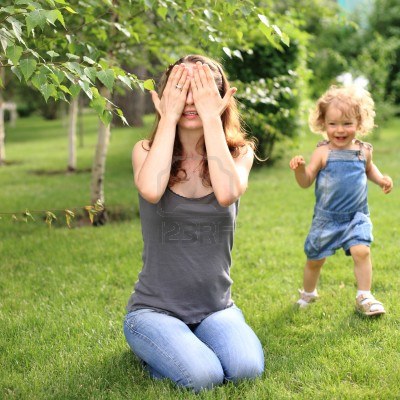On the one hand, teaching children is easier than teaching adults: children are more responsive; they take everything in like sponges and readily share what they have assimilated. On the other hand, dealing with children can be a far more demanding job: they flat refuse to do what they are not interested in, their attention is easily distracted and they float from one topic to another in a butterfly-like manner.
When I was not a mother myself I avoided working with children because of the difficulties involved. But raising a bilingual child has changed my attitude: now I adore teaching children as I can see in them much more potential than in adults. I hope my experience will be helpful for a colleague whose letter I received recently:
Dear Olga,
I am currently teaching a bright 5 year old whose mother found your website and recommended it to me. Unfortunately, my Russian isn't so great, so she has translated some of it for me. She's told me about your system: First, read a story. Next, practice sentences. Finally, play games to help them remember and enjoy it.
Do you have any extra advice you might be able to give me? He really enjoys the games but is bored when we practice sentences and reading. I try to make practicing sentences more enjoyable by showing him pictures and having him make sentences from the pictures. This works alright, but he is still not so interested.
I have heard that your young daughter is quite good at English, and we hope that our 5 year old will soon be as good.
Thanks for your advice!
Dear colleague, thank you for asking. I believe you addressed the right person for although I have made mistakes in the past, I learned from them by drawing my own conclusions. And finally I have discovered for myself an answer to the question you pose. But I can't be so definite as to what helped me more in doing so: my extensive teaching experience or speaking English to my own child. So I just decided to share with you the way I spend my English time with my daughter as well as with other children.
Here are the five simple principles I’ve come to. They can be called the essence of my teaching conception: I find them most helpful in my work and I hope they will prove useful to you.
 Follow your student's interests
Follow your student's interests
When I meet a new child I’m going to teach, my first priority is to get to know him. We play the games he offers and speak on the topics he is interested in. If a child doesn’t know any English, it is always possible to establish communication through pictures and gestures. When the child develops some trust in me, I begin to offer my own games and other pastimes such as drawing etc.
 No textbooks are needed
No textbooks are needed
I never offer children textbooks and always feel surprised and somewhat disappointed when their parents insist on it. I believe it is one of the biggest mistakes a teacher can make. (The other one is to start by teaching your young student letters and sounds.) A textbook stands between you and the child. By letting a third party (the author with his own logic, different from yours) into your teacher-student relationship you can easily ruin the fragile bridge of understanding that has been built between you and the child. No matter how talented or experienced the author may be he can't feel your student as you do. Only you as a teacher can choose the right activity at the right time.
Children are so open-minded and willing to learn that it is easy to teach them by just speaking to them and playing with them. There is sure to be a topic your young student is interested in. Develop it in different ways: discuss it, make up some simple games centered around it. Your reward will be trust and interest in your pupil’s eyes.
 Make sure you are understood
Make sure you are understood
Working with children (in fact it is the same with adults) it is very important to make sure your pupil understands what you are saying/reading to him. If it is a story or a fairy-tale, read it to him slowly, using all the expressive means you are capable of.
It is a good idea to imagine yourself an actor on the stage. But always keep in mind that the most important thing for you is to keep in touch with your “audience”: stop frequently, ask questions, discuss the pictures in your book or point to real objects that surround you to make sure your pupil understands you.
Remember that reading to children/telling them a story is not your monologue – it should be a dialogue. One of the most effective ways to involve your young students in your story is to act out the story.
 Practice grammar in games
Practice grammar in games
In your letter you refer to sentences. If you mean grammar structures, I don’t ordinarily use them in my work with children. The only way I feel I have a right to draw a child’s attention to a certain scheme is in a game. So the rule I follow is “Practice sentences in games or don’t practice them at all”.
For example if we play shop, we obviously use such structures us:
What would you like to buy?
Would you like some cheese or some milk?
I would like some chocolate, please.
When we play hide-and-seek, we revise prepositions as well as questions and answers:
Where are you?
Are you between the sofa and the door? No, you are not here.
Are you behind the curtain? Yes, here you are!

I think you have grasped the idea.
 Live in English, don’t teach it
Live in English, don’t teach it
Working with children, I don’t really teach my pupils English. Instead we live together in English. It is much easier to do it with your own child than with another student but it is certainly worth a try. My daughter and I often draw or model something in English, we cook in English, we tidy up in English and we get dressed in it. Thus the situations become familiar and each time the child feels more and more at home in them. As the progress goes on, I introduce new words and their combinations.
It is also a good idea to recreate different situations while playing. You and your pupil can pick up roles (for example, shop-assistant and customer, doctor and patient etc.) and act out real-life situations. Another alternative is to use toys.
I hope the advice I have provided will prove useful to you and your 5-year-old student. Will be looking forward to hearing from you.

Children are so different that working with a group of children is very hard. Everyone needs your attention, everyone wants to be heard. When you work one on one, then it is very rewarding. You look at your teaching as a long journey, you know where you have started and how much you have accomplished. Sometimes the journey is very slow and tiresome, sometimes it is fast and full of joy, but together with your child (little student) you are having good time and learn something new one step at a time. I think that your principles for that language learning journey are good and right. Thank you for a wonderful article!
Agree with you, Zelya: teaching a group of children is quite a challenging job. But it is more fun. I'm glad you liked my answer.
I'm glad you liked my answer.
The best rule is "use only English at the lesson". Very often the pictures are enough to give children a clear idea of what the tale is about. There is a difficult moment in teaching children: the teacher has to keep them lively, active and interested during the whole process of the lesson and pay attention to the every kid`s grammar, pronunciation, intonation.
What do you think about Pr Cont and Pr Ind? Many teachers fear that the children get confused if they are taught these tenses in the same time.
Well, I didn't mention this rule because I presumed it goes without saying. But you may be right, Tanya, and it is necessary to mention it for our non-native-English-speaking readers.
As to the two tenses, children do sometimes mix them up. As well as a variety of other tenses. But it happens only when you start teaching them.
As long as you just play with children in English (without trying to teach them), they don't mix anything up. Their motivation for playing is far greater than any obstacle grammar may present.
It's a great pleassure discovering there are teachers and parents sharing this seemingly common-sence approach to introducing languages. You're doing great job.